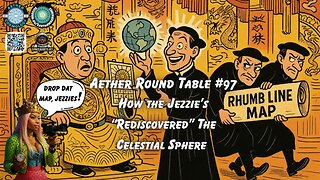Premium Only Content

the astrolabe
Ladz, The Astrolabe
https://geogebra.org/m/HNFgEkzf
The astrolabe represents the celestial sphere as seen from Earth, with our world at the center. This aligns perfectly with our flat Earth reality, where the celestial bodies rotate above us in the firmament. The astrolabe uses stereographic projection to map the celestial sphere onto a flat plane. This projection works because we're observing a dome-like sky above a flat plane, not a curved surface. The astrolabe measures altitude (height above the horizon) and azimuth (direction) of celestial bodies. These measurements only make sense from a fixed, flat Earth perspective. The astrolabe can determine local time based on the positions of stars. This relies on the consistent, predictable motion of the celestial sphere above our flat plane. Astrolabes can determine latitude by measuring the altitude of Polaris or the Sun at noon. This works because these objects maintain consistent positions relative to our flat Earth.
Why the astrolabe makes no sense in a heliocentric model:
Why it makes no sense on your model.
Earth's Alleged Motion:
In a heliocentric model, Earth would be spinning and orbiting the Sun at high speeds. This would make consistent celestial observations impossible without complex calculations to account for this motion.
Changing Perspective:
A spinning, orbiting Earth would constantly change its orientation relative to the stars, making the fixed star positions on the astrolabe's rete useless.
Relativity of Motion:
The heliocentric model introduces unnecessary complications like relativity, which the simple, elegant astrolabe doesn't account for or need.
Curvature Issues:
A globe Earth would introduce curvature problems that the flat projections used in astrolabes don't address.
Consistency Across Latitudes:
Astrolabes work consistently across all latitudes on our flat Earth. On a globe, you'd need different astrolabes for different latitudes to account for the alleged curvature.
The math behind the Astrolabe
The astrolabe is a two-dimensional model of the celestial sphere, typically made of brass or wood, consisting of several key components:
Mater (Mother): The main circular plate with a raised rim.
Tympan (Climate): A plate that fits inside the mater, engraved with altitude and azimuth lines.
Rete (Spider): A latticed disk that rotates over the tympan, representing the positions of fixed stars.
Rule: A rotating bar used for measurements.
Alidade: A sighting device on the back for measuring celestial altitudes.
Stereographic Projection
The astrolabe uses stereographic projection to map the celestial sphere onto a plane.
The mathematical formula for this projection is:
(𝑥,𝑦)=(2𝑅cos𝜙sin𝜆1+sin𝜙,2𝑅cos𝜙cos𝜆1+sin𝜙)
(x,y)=(1+sinϕ2Rcosϕsinλ,1+sinϕ2Rcosϕcosλ)
Where:
$Ris the radius of the celestial sphere
$\phi$ is the latitude
$\lambda$ is the longitude
Altitude and Azimuth Lines
The tympan is marked with altitude circles (almucantars) and azimuth arcs. The equation for an almucantar is:
𝑟=𝑅cot(𝑎2)r=Rcot(2a)
Where:
$r$ is the radius of the almucantar circle
$R$ is the radius of the astrolabe
$a$ is the altitude angle
Time Calculation
To find the time, we use the equation of time:
𝐸=𝐿𝑠−𝑅𝐴E=Ls−RAW
here:
$E$ is the equation of time
$L_s$ is the mean longitude of the Sun
$RA$ is the right ascension of the Sun
Determining Latitude
The latitude can be calculated using the altitude of Polaris:
Latitude=90∘−Zenith Distance of Polaris
Angular Measurements
The astrolabe can measure angles with remarkable precision. The angular resolution ($\theta$) is given by:
𝜃=360∘2𝜋𝑅θ=2πR360∘
Where $R$ is the radius of the astrolabe in millimeters.
Celestial Coordinates
The astrolabe can convert between equatorial and horizontal coordinate systems:
Equatorial to Horizontal:
sin(𝑎)=sin(𝛿)sin(𝜙)+cos(𝛿)cos(𝜙)cos(𝐻)sin(a)
=sin(δ)sin(ϕ)+cos(δ)cos(ϕ)cos(H)cos(𝐴)
=sin(𝛿−sin(𝜙)sin(𝑎)cos(𝜙)cos(𝑎)cos(A)
=cos(ϕ)cos(a)sin(δ)−sin(ϕ)sin(a)
Where:
$a$ is altitude
$A$ is azimuth
$\delta$ is declination
$\phi$ is observer's latitude
$H$ is hour angle
😆😅
5 mins explaining each part of the astrolabe.
https://x.com/AntiDisinfo86/status/1802858865119334663
What can the astrolabe teach us about Stereographic projection?
https://x.com/AntiDisinfo86/status/1802786574515450134
-
 1:57:41
1:57:41
Anti-Disinfo League
10 days agoChill Sesh with #FlatEarthGang on #clubhouse How to use Stellarium
391 -
 LIVE
LIVE
GritsGG
3 hours agoRumble Customs! 3515 Ws! 🫡!
655 watching -
 LIVE
LIVE
Grant Stinchfield
1 hour agoHow Local TV News LOST Its Soul
128 watching -

Badlands Media
11 hours agoBadlands Daily: September 1, 2025
18.5K11 -
 1:12:35
1:12:35
theoriginalmarkz
2 hours agoCoffee with MarkZ. 09/01/2025
22.6K7 -
 2:59:48
2:59:48
Wendy Bell Radio
7 hours agoSunday, Bloody Sunday
96.8K212 -
 DVR
DVR
crgoodw1n
1 hour agoHAPPY LABOR DAY! Tactical shoosting W/ @BenderOdoyle Ask about !12hr !freshenup !discord
642 -
 LIVE
LIVE
ENEMYOFDEATH2012
13 hours agoGod of War Playthrough Pt. 2 and some Fortnite
25 watching -
 4:47:50
4:47:50
The Why Files
2 days agoCOMPILATION: UFOs and Aliens Vol.2 | They are NOT our friends
84.3K53 -
 1:33:46
1:33:46
BubbaMatt
2 hours agoMafia Definitive Edition Playthrough - Part 1
26